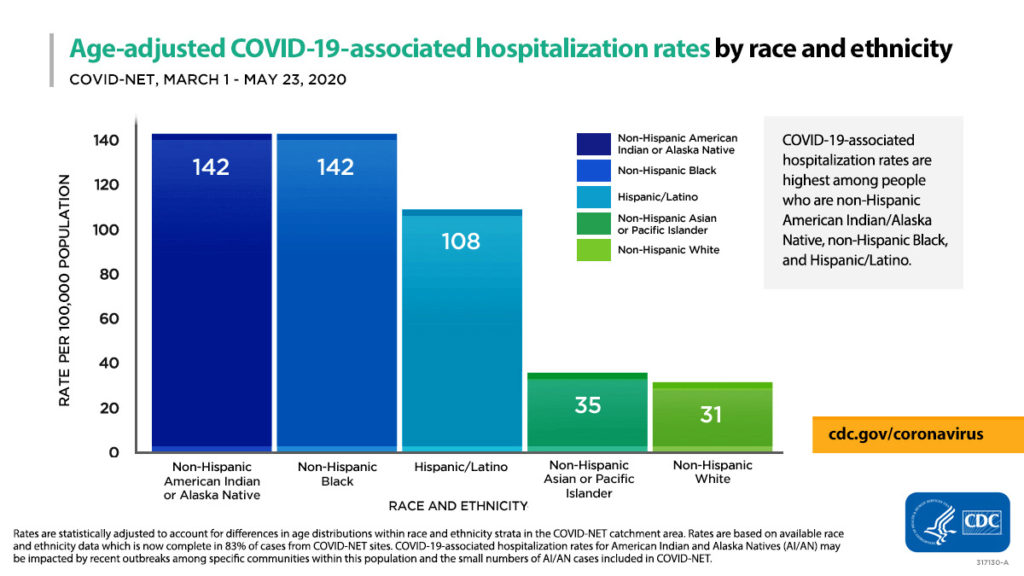
As of now, Washington state has 19,585 coronavirus cases and 1,055 deaths. Out of those 19,585 confirmed cases 15,127 are minorities. Out of the 15,127 minorities, 5,885 are Hispanic, 1,029 are Black, 1,136 are Asian, and 201 are Native American. Minorities make up 61% of all COVID-19 confirmed cases in Washington state as stated by the Washington State Department of Health.
Ana Lucero Hurtado, the president of Latinos Unidos, states that her community dislikes the ongoing progression of the COVID-19 pandemic.
“We don’t like all the isolation and it has brought up uncertainty of how to continue supporting our families,” Hurtado said.
With our current political climate, minority groups are fearing reaching out for assistance.
“It was not long ago that it was our Latino communities in the news. Raids and mass ICE apprehensions and families being torn apart. Babies and children separated from their parents and put into camps,” Hurtado said.
U.S Immgration and Customs Enforcement states that their mission is to protect America from cross border crime and illegal immgration that threaten national security and public safety.
Early in 2017, Donald Trump announced that 11 million immigrants in the United States, legal or not, would have the chance to be detained and deported by ICE. The Trump administration altered the executive branch policymakers perspective on immigrants. Instead of immigrants being viewed as helpful to the American society, Trump’s administration plastered the view of immigrants being a threat and a danger to the American society into policymakers’ hands.
“It causes us great outrage and sadness to see what is going on in the country right now. It makes us wonder if the sacrifice of leaving our own countries in search of a better future for our families, was worth it,” the president of the Latinos Unidos club, Ana Lucero Hurtado said.
Trump declared a National Emergency regarding the southern border of the United States. Trump attributed this National Emergency to an invasion of migrants who apparently had the potential to commit crimes in the United States. Even though over half (60%) immigrants detained by U.S Immgration and Customs Enforcement did not have a criminal record.
In ICE detention centers, U.S Customs and Border Protection (CBP) often violated federal guidelines. CBP kept children for over 72 hours before taking them to the Health and Human services office of Refugee Resettlement. Children were left in these ICE detention centers for up to 25 days unaccompanied. Between the dates of May 5, 2018 and June 20, 2018 over 800 immigrant children were separated from their families from the sectors of El Paso and Rio Grande Valley. Between December of 2018 and July of 2019, six children have died while being detained under Trump’s administration according to the CBP.
Other violations of CBP standards include not granting children the right to showers and hot meals. The majority of people who were detained for more than 72 hours, were not allowed a shower. Most adults who were detained in ICE detention centers were only given bologna sandwiches for meals as stated by the US Customs and Border Protection in Texas. This action resulted in many requiring medical assistance according to the CBP.
“People of color face many hardships and discrimination. It seems that is the price we pay to be here,” said Hurtado.
Coronavirus took the life of a 57-year-old male from El Salvador while being detained at Otay Mesa detention center. According to the U.S Immigration and Customs Enforcement website, 2,781 people who are detained at an ICE detention center were tested for COVID-19. There are 754 positive cases as of now.
The indigenous people of America are being greatly affected by COVID-19. The Indian Health Service reported that 4,000 positive COVID-19 cases across 12 regions. The federal government spends $12,744 for one person on medicare, $9,404 for one person on veterans health, and only $2,834 for one person on healthcare for American Indians. The federal government spends more money on health care for federal inmates than patients on healthcare for American Indians. In 2016, the Federal government spent $8,602 per federal inmate in contrast to $2,834 per patient on health care for American Indians.
Approximately 700,000 Native Americans live on 334 reservations across the United States. The poverty rate on reservations is currently at 28.5% while the national average is 12.7%. Four out of the 10 largest reservations have poverty rates of more than 50%. Those reservations being Fort Peck Indian Reservation (58.5%), Pine Ridge Indian Reservation (52.8%), San Carlos Indian Reservation (52.6%), Uintah and Ouray Indian Reservation (54.4%) according to the US Census Bureau.
The Pine Ridge Comprehensive Health Facility is a hospital on the Pine Ridge Indian Reservation in South Dakota. The Health Facility is run by the underfunded and understaffed Indian Health Service. According to the American Medical Association, the money that is funded to the Indian Health Service is spent on medical care and not public health programs.
The Indian Health Service has currently administered a total of 154,043 COVID-19 tests. Out of those 154,043 COVID-19 tests, 12,719 came back as positive for the virus according to The Indian Health Service’s website. The number of positive cases among Native Americans are quickly increasing. Between 40% and 50% of homes on the Navajo reservation do not have running water which makes the virus spread among people even faster. Due to the lack of basic necessities caused by the absence of funding by the government, reservations are in great need of adequate funding.
“People of color have always walked on eggshells in this country. It appears not much has changed,” Hurtado said.